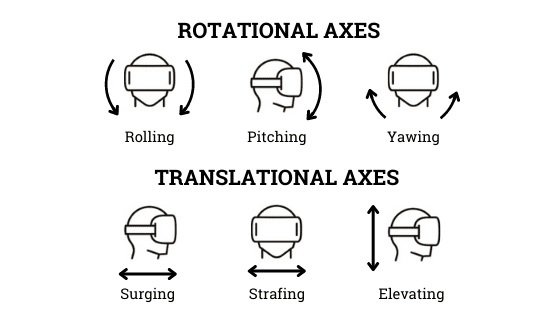What is DoF?
DoF is a term often used when describing a specific feature of a VR headset. The acronym stands for degrees of freedom. Essentially, it is a term outlining motion about several axes. Relating to VR, it is used to explain how an individual can move in a headset and the number of axes that are tracked.
Headsets can either be 3 DoF or 6 DoF, meaning they can move along 3 or 6 different axes. Think of it this way: our knees can only move forward and backward. The bone itself cannot move up and down, left and right, or tilt from side to side. That range means that our knees move in 1 DoF.
Rotational and Translational Axes
There are six different axes that we can move about: three are rotational and three are translational. They move along the x, y, and z axes. 3 DoF headsets can move along one group of these axes – whether rotational or translational – but not both. Meanwhile, 6 DoF headsets can move along both rotational and translational axes.

Rotational Axes
Rolling
Rolling defines the ability to tilt from left to right. You would be facing forward but leaning over to one side. Try it yourself: bring your right ear to your right shoulder, return to the centre, and then bring your left ear to your left shoulder.
Pitching
The ability to look up and down along a vertical axis is known as pitching. If you were to try this, you would bring your chin down to your neck, return to then centre, and then move it up away from your neck.
Yawing
The movement of yawing is the twisting of your head from left to right. To do this, twist your head to the right so your chin aligns almost vertically with the top of your shoulder. Then do the same on the left side.
Translational Axes
Surging
Surging is the ability to move forward and backwards in an environment. You can move closer and farther away from an object and have the ability to step forward or back while being tracked in the headset.
Strafing
The ability to move from side to side is known as strafing. Take a step to the left or the right and the headset will show movement within the environment in the same way.
Elevating
Finally, elevating describes up and down movement. The headset can track whether you crouch down or jump up.
3 DoF vs. 6 DoF
As mentioned above, 3 DoF headsets restrict you to one group of axes, whether rotational or translational. These work best when you want to watch a film or experience 360 video. A user can visualize the virtual environment and look at the detail but cannot fully immerse themselves in the environment. Even with controllers, it is often not possible to interact with objects beyond simple point-and-click.
On the other hand, 6 DoF headsets allow for tracking of the position and orientation within a headset. You can track both head and body movement in a 3D environment. To fully immerse a user, the environment needs to be true virtual reality rather than 360 video. The user can then interact with, look around, and move within the virtual world.
With advancements in headset technology, headset vendors are turning to developing more robust 6 DoF headsets over 3 DoF headsets. This is evident with the discontinuation of the Oculus Go and shows the trend towards 6 DoF headsets.
Which is better for training in VR?
6 DoF headsets are becoming more accessible with prices dropping steadily. They are also developing quickly in hardware and software. 6 DoF headsets used to require tethers and external cameras to triangulate a user’s position in the virtual world. With the evolution of untethered headsets, users can now move freely and transport the headsets easily.
For the best, most immersive training experience, we recommend going with a 6 DoF headset. For trainees to interact fully with their environment, 6 DoF is necessary. Trainees can move around the room and pick up and move items, all while developing muscle memory.
Are you currently looking for a VR vendor? The long-term viability of your project depends on choosing the right one. Here are 15 questions every VR vendor should be able to answer:
Download the checklist: 15 Questions for your VR Vendor.
Latest Posts
- « Previous
- 1
- …
- 6
- 7
- 8
Stay in the Know
Want to stay up-to-date with what is going on in the world of immersive training? Subscribe to the Motive Blog.
Ready to revolutionize your training program?
We’re ready to show you how seamlessly you can create, edit and deploy VR training modules. Our team is standing by to help you revolutionize your training program.





